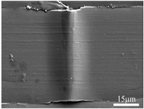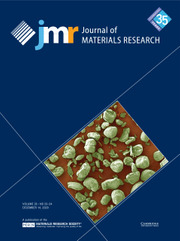Crossref Citations
This article has been cited by the following publications. This list is generated based on data provided by
Crossref.
Sahay, Rahul
Agarwal, Komal
Subramani, Anbazhagan
Raghavan, Nagarajan
Budiman, Arief S.
and
Baji, Avinash
2020.
Helicoidally Arranged Polyacrylonitrile Fiber-Reinforced Strong and Impact-Resistant Thin Polyvinyl Alcohol Film Enabled by Electrospinning-Based Additive Manufacturing.
Polymers,
Vol. 12,
Issue. 10,
p.
2376.
Guo, Qianying
Gu, Yucong
Barr, Christopher M.
Koenig, Thomas
Hattar, Khalid
Li, Lin
and
Thompson, Gregory B.
2020.
In situ indentation and high cycle tapping deformation responses in a nanolaminate crystalline/amorphous metal composite.
Materials Science and Engineering: A,
Vol. 798,
Issue. ,
p.
140074.
Mishra, Ashwini Kumar
Lambai, Aloshious
Jayaram, Vikram
and
Jaya, Balila Nagamani
2020.
The edge-notched clamped beam bend specimen as a fracture toughness test geometry.
Theoretical and Applied Fracture Mechanics,
Vol. 105,
Issue. ,
p.
102409.
Dong, Mengya
Deng, Qi
Zhang, Yumei
Hang, Tao
and
Li, Ming
2020.
Study on the relationship between Cu protrusion behavior and stresses evolution in the through-silicon via characterized by in-situ μ-Raman spectroscopy.
Microelectronics Reliability,
Vol. 115,
Issue. ,
p.
113949.
Sun, Yufeng
Chen, Yao
Tsuji, Nobuhiro
and
Guan, Shaokang
2020.
Microstructural evolution and mechanical properties of nanostructured Cu/Ni multilayer fabricated by accumulative roll bonding.
Journal of Alloys and Compounds,
Vol. 819,
Issue. ,
p.
152956.
Liu, Yang
Wang, Xing
Zhu, Daibo
Li, Yuanzhe
Yao, Bingqing
Sun, Tianyou
and
Miao, Hualei
2021.
Enhancing strength and ductility in carbon nanotubes reinforced zinc matrix composites by in-situ formation of ZnC8.
Materials Science and Engineering: A,
Vol. 803,
Issue. ,
p.
140512.
Sahay, Rahul
Budiman, Arief S.
Harito, Christian
Gunawan, Fergyanto E.
Navarro, Etienne
Escoubas, Stéphanie
Cornelius, Thomas W.
Aziz, Izzat
Lee, Pooi See
Thomas, Olivier
and
Raghavan, Nagarajan
2021.
Berkovich nanoindentation study of 16 nm Cu/Nb ARB nanolaminate: Effect of anisotropy on the surface pileup.
MRS Advances,
Vol. 6,
Issue. 19,
p.
495.
Song, Jian
Wang, Jian
and
Liu, Yue
2021.
Characterization of the terrace-defect interfaces using in situ straining techniques.
Journal of Materials Research,
Vol. 36,
Issue. 13,
p.
2674.
Cui, Yuchi
Derby, Benjamin
Li, Nan
and
Misra, Amit
2021.
Fracture resistance of hierarchical Cu–Mo nanocomposite thin films.
Materials Science and Engineering: A,
Vol. 799,
Issue. ,
p.
139891.
Budiman, Arief S.
Sahay, Rahul
Anwar Ali, Hashina Parveen
Tippabhotla, Sasi K.
Radchenko, Ihor
and
Raghavan, Nagarajan
2021.
Interface-mediated plasticity and fracture in nanoscale Cu/Nb multilayers as revealed by in situ clamped microbeam bending.
Materials Science and Engineering: A,
Vol. 803,
Issue. ,
p.
140705.
Chen, Jiao
Yoshida, Kenta
Suzudo, Tomoaki
Shimada, Yusuke
Inoue, Koji
Konno, Toyohiko J.
and
Nagai, Yasuyoshi
2022.
<i>In Situ</i> TEM Observation and MD Simulation of Frank Partial Dislocation Climbing in Al–Cu Alloy.
MATERIALS TRANSACTIONS,
Vol. 63,
Issue. 4,
p.
468.
Sahay, Rahul
Budiman, Arief S.
Aziz, Izzat
Navarro, Etienne
Escoubas, Stéphanie
Cornelius, Thomas W.
Gunawan, Fergyanto E.
Harito, Christian
Lee, Pooi See
Thomas, Olivier
and
Raghavan, Nagarajan
2022.
Crystallographic Anisotropy Dependence of Interfacial Sliding Phenomenon in a Cu(16)/Nb(16) ARB (Accumulated Rolling Bonding) Nanolaminate.
Nanomaterials,
Vol. 12,
Issue. 3,
p.
308.
Budiman, A.S.
Illya, G.
Anbazhagan, S.
Tippabhotla, S.K.
Song, W.J.
Sahay, R.
and
Tay, A.A.O.
2022.
Enabling lightweight polycarbonate-polycarbonate (PC-PC) photovoltaics module technology – Enhancing integration of silicon solar cells into aesthetic design for greener building and urban structures.
Solar Energy,
Vol. 235,
Issue. ,
p.
129.
Jaya, Balila Nagamani
2022.
Fracture in small-scale structures and confined volumes.
MRS Bulletin,
Vol. 47,
Issue. 8,
p.
832.
Sahay, Rahul
Tu, Yen-Cheng
Aziz, Izzat
Budiman, Arief S.
Tan, Cher Ming
Lee, Pooi See
Thomas, Olivier
and
Raghavan, Nagarajan
2023.
Investigation of the reliability of nano-nickel/niobium oxide-based multilayer thin films deposited on polymer substrates for flexible electronic applications.
Materials Advances,
Vol. 4,
Issue. 15,
p.
3257.
Liu, Yanwei
Ma, Hansong
Long, Hao
Wei, Shiyuan
Zhang, Siyuan
and
Wei, Yueguang
2023.
Multi-scale indentation model of stiff film-compliant substrate structures.
Applied Mathematical Modelling,
Vol. 119,
Issue. ,
p.
566.





